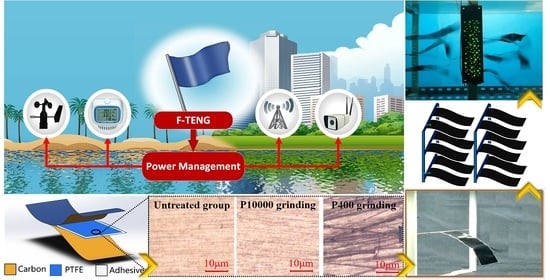An Array of Flag-Type Triboelectric Nanogenerators for Harvesting Wind Energy
Abstract
:1. Introduction
2. Materials and Methods
2.1. The Working Principle of a Single F-TENG
2.2. The Fabrication and Pre-Grinding of an F-TENG
2.3. Experimental Setup
2.4. Horizontal and Vertical Parallel Arrays of Double F-TENGs
3. Results and Discussion
3.1. The Output Performance of a Single F-TENG with Different Pre-Grinding
3.2. Horizontal and Vertical Parallel Array Characterization of the Double F-TENGs
3.3. Generation Performance of the F-TENGs Network
4. Conclusions
5. Experimental Section
5.1. The Fabrication of the F-TENG Unit and Network
5.2. Electrical Measurement of the TENG Unit and Network
Author Contributions
Funding
Institutional Review Board Statement
Informed Consent Statement
Data Availability Statement
Conflicts of Interest
References
- Wendler, R.; Calderón-Muñoz, W.R.; LeBoeuf, R. Energy-based iteration scheme of the double-multiple streamtube model in vertical-axis wind turbines. Acta Mech. 2016, 227, 3295–3303. [Google Scholar] [CrossRef]
- Zhou, A.; Yu, D.; Wu, X.; Liu, J.; Li, R. Research on Intelligent Fault Diagnosis for Large-scale Wind Turbines Based on Ontology. China Mech. Eng. 2012, 23, 2075–2080. [Google Scholar]
- Li, S.; Yuan, J.; Lipson, H. Ambient wind energy harvesting using cross-flow fluttering. J. Appl. Phys. 2011, 109, 026104. [Google Scholar] [CrossRef] [Green Version]
- Perković, L.; Silva, P.; Ban, M.; Kranjčević, N.; Duić, N. Harvesting high altitude wind energy for power production: The concept based on Magnus’ effect. Appl. Energy 2013, 101, 151–160. [Google Scholar] [CrossRef]
- Ji, J.; Kong, F.; He, L.; Guan, Q.; Feng, Z. Piezoelectric Wind-Energy-Harvesting Device with Reed and Resonant Cavity. Jpn. J. Appl. Phys. 2010, 49, 311–333. [Google Scholar] [CrossRef]
- Perez, M.; Boisseau, S.; Gasnier, P.; Willemin, J.; Reboud, J.L. An electret-based aeroelastic flutter energy harvester. Smart Mater. Struct. 2015, 24, 035004. [Google Scholar] [CrossRef]
- Xu, M.Y.; Wang, P.H.; Wang, Y.C.; Zhang, S.; Wang, A.; Zhang, C.L.; Wang, Z.J.; Pan, X.X.; Wang, Z.L. A Soft and Robust Spring Based Triboelectric Nanogenerator for Harvesting Arbitrary Directional Vibration Energy and Self-Powered Vibration Sensing. Adv. Energy Mater. 2017, 8, 1702432. [Google Scholar] [CrossRef]
- Liang, X.; Jiang, T.; Liu, G.; Feng, Y.; Zhang, C.; Wang, Z.L. Spherical triboelectric nanogenerator integrated with power management module for harvesting multidirectional water wave energy. Energy Environ. Sci. 2020, 13, 277–285. [Google Scholar] [CrossRef]
- Gallardo-Vega, C.; Lopez-Lagunes, O.; Nava-Galindo, O.I.; De Leon, A.; Romero-Garcia, J.; Antonio Aguilera-Cortes, L.; Martinez-Castillo, J.; Herrera-May, A.L. Triboelectric Energy Harvester Based on Stainless Steel/MoS2 and PET/ITO/PDMS for Potential Smart Healthcare Devices. Nanomaterials 2021, 11, 1533. [Google Scholar] [CrossRef]
- Garofalo, E.; Cecchini, L.; Bevione, M.; Chiolerio, A. Triboelectric Characterization of Colloidal TiO2 for Energy Harvesting Applications. Nanomaterials 2020, 10, 1181. [Google Scholar] [CrossRef]
- Zhao, H.F.; Xiao, X.; Xu, P.; Zhao, T.C.; Song, L.G.; Pan, X.X.; Mi, J.C.; Xu, M.Y.; Wang, Z.L. Dual-Tube Helmholtz Resonator-Based Triboelectric Nanogenerator for Highly Efficient Harvesting of Acoustic Energy. Adv. Energy Mater. 2019, 9, 10. [Google Scholar] [CrossRef]
- Shankaregowda, S.A.; Ahmed, R.; Liu, Y.; Nanjegowda, C.B.; Cheng, X.; Shivanna, S.; Ramakrishna, S.; Yu, Z.F.; Zhang, X.; Sannathammegowda, K. Dry-Coated Graphite onto Sandpaper for Triboelectric Nanogenerator as an Active Power Source for Portable Electronics. Nanomaterials 2019, 9, 12. [Google Scholar] [CrossRef] [PubMed] [Green Version]
- Xu, M.Y.; Zhao, T.C.; Wang, C.; Zhang, S.L.; Li, Z.; Pan, X.X.; Wang, Z.L. High Power Density Tower-like Triboelectric Nanogenerator for Harvesting Arbitrary Directional Water Wave Energy. ACS Nano 2019, 13, 1932–1939. [Google Scholar] [CrossRef] [PubMed]
- Yang, Y.; Zhu, G.; Zhang, H.L.; Chen, J.; Zhong, X.D.; Lin, Z.H.; Su, Y.J.; Bai, P.; Wen, X.N.; Wang, Z.L. Triboelectric Nanogenerator for Harvesting Wind Energy and as Self-Powered Wind Vector Sensor System. ACS Nano 2013, 7, 9461–9468. [Google Scholar] [CrossRef]
- Bae, J.; Lee, J.; Kim, S.; Ha, J.; Lee, B.S.; Park, Y.; Choong, C.; Kim, J.B.; Wang, Z.L.; Kim, H.Y.; et al. Flutter-driven triboelectrification for harvesting wind energy. Nat. Commun. 2014, 5, 4929. [Google Scholar] [CrossRef] [Green Version]
- Wang, S.H.; Mu, X.J.; Wang, X.; Gu, A.Y.; Wang, Z.L.; Yang, Y. Elasto-Aerodynamics-Driven Triboelectric Nanogenerator for Scavenging Air-Flow Energy. ACS Nano 2015, 9, 9554–9563. [Google Scholar] [CrossRef]
- Zhao, Z.F.; Pu, X.; Du, C.H.; Li, L.X.; Jiang, C.Y.; Hu, W.G.; Wang, Z.L. Freestanding Flag-Type Triboelectric Nanogenerator for Harvesting High-Altitude Wind Energy from Arbitrary Directions. ACS Nano 2016, 10, 1780–1787. [Google Scholar] [CrossRef]
- Wang, Y.; Yang, E.; Chen, T.Y.; Wang, J.Y.; Hu, Z.Y.; Mi, J.C.; Pan, X.X.; Xu, M.Y. A novel humidity resisting and wind direction adapting flag-type triboelectric nanogenerator for wind energy harvesting and speed sensing. Nano Energy 2020, 78, 105279. [Google Scholar] [CrossRef]
- Bhunia, S.; Chandel, S.; Karan, S.K.; Dey, S.; Tiwari, A.; Das, S.; Kumar, N.; Chowdhury, R.; Mondal, S.; Ghosh, I.; et al. Autonomous self-repair in piezoelectric molecular crystals. Science 2021, 373, 321–327. [Google Scholar] [CrossRef]
- You, Y.M.; Liao, W.Q.; Zhao, D.; Ye, H.Y.; Zhang, Y.; Zhou, Q.; Niu, X.; Wang, J.; Li, P.F.; Fu, D.W.; et al. An organic-inorganic perovskite ferroelectric with large piezoelectric response. Science 2017, 357, 306–309. [Google Scholar] [CrossRef] [Green Version]
- Karan, S.K.; Maiti, S.; Lee, J.H.; Mishra, Y.K.; Khatua, B.B.; Kim, J.K. Recent Advances in Self-Powered Tribo-/Piezoelectric Energy Harvesters: All-In-One Package for Future Smart Technologies. Adv. Funct. Mater. 2020, 30, 52. [Google Scholar] [CrossRef]
- Halder, L.; Maitra, A.; Das, A.K.; Bera, R.; Karan, S.K.; Paria, S.; Bera, A.; Si, S.K.; Khatua, B.B. Fabrication of an Advanced Asymmetric Supercapacitor Based on Three-Dimensional Copper–Nickel–Cerium–Cobalt Quaternary Oxide and GNP for Energy Storage Application. ACS Appl. Electron. Mater. 2019, 1, 189–197. [Google Scholar] [CrossRef]
- Niu, S.M.; Wang, Z.L. Theoretical systems of triboelectric nanogenerators. Nano Energy 2015, 14, 161–192. [Google Scholar] [CrossRef] [Green Version]
- Yang, E.; Wang, Y.; Wang, J.Y.; Wang, C.; Liu, C.X.; Wu, M.W.; Mi, J.C.; Xu, M.Y. Research on a film-flapping triboelectric nanogenerator for wind energy harvesting. Sci. Sin. Technol. 2021, 51, 684–698. [Google Scholar] [CrossRef]
- Xu, W.H.; Zheng, H.X.; Liu, Y.; Zhou, X.F.; Zhang, C.; Song, Y.X.; Deng, X.; Leung, M.; Yang, Z.B.; Xu, R.X.; et al. A droplet-based electricity generator with high instantaneous power density. Nature 2020, 578, 392–396. [Google Scholar] [CrossRef]
- Zhu, L. Interaction of two tandem deformable bodies in a viscous incompressible flow. J. Fluid Mech. 2009, 635, 455–475. [Google Scholar] [CrossRef] [Green Version]
- Wang, S.; Sun, C.; Yin, X. Experiment of the Flapping Coupling Modes between Two Parallel Flags in a Aniform Flow. J. Exp. Mech. 2010, 25, 401–407. [Google Scholar]

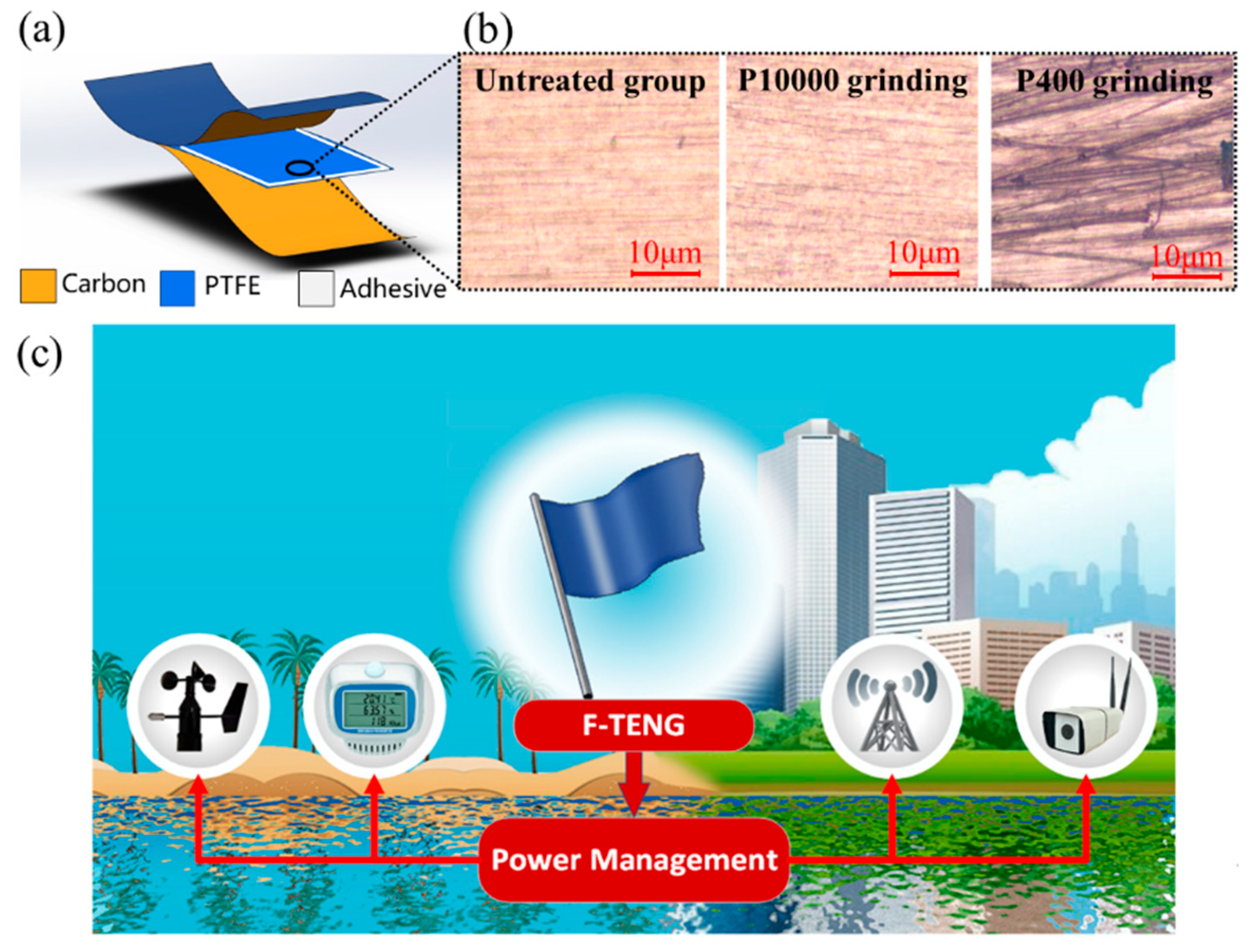
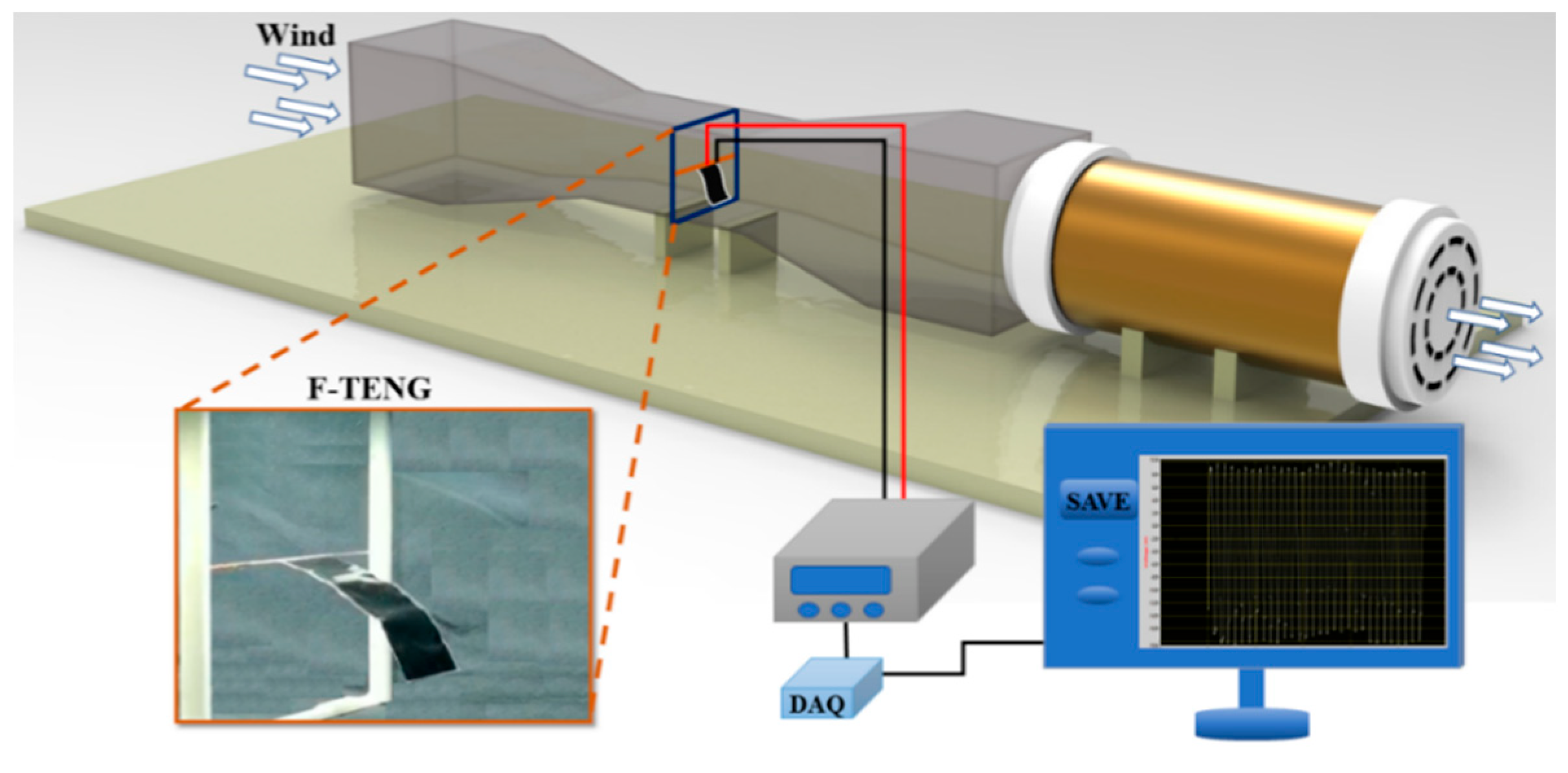


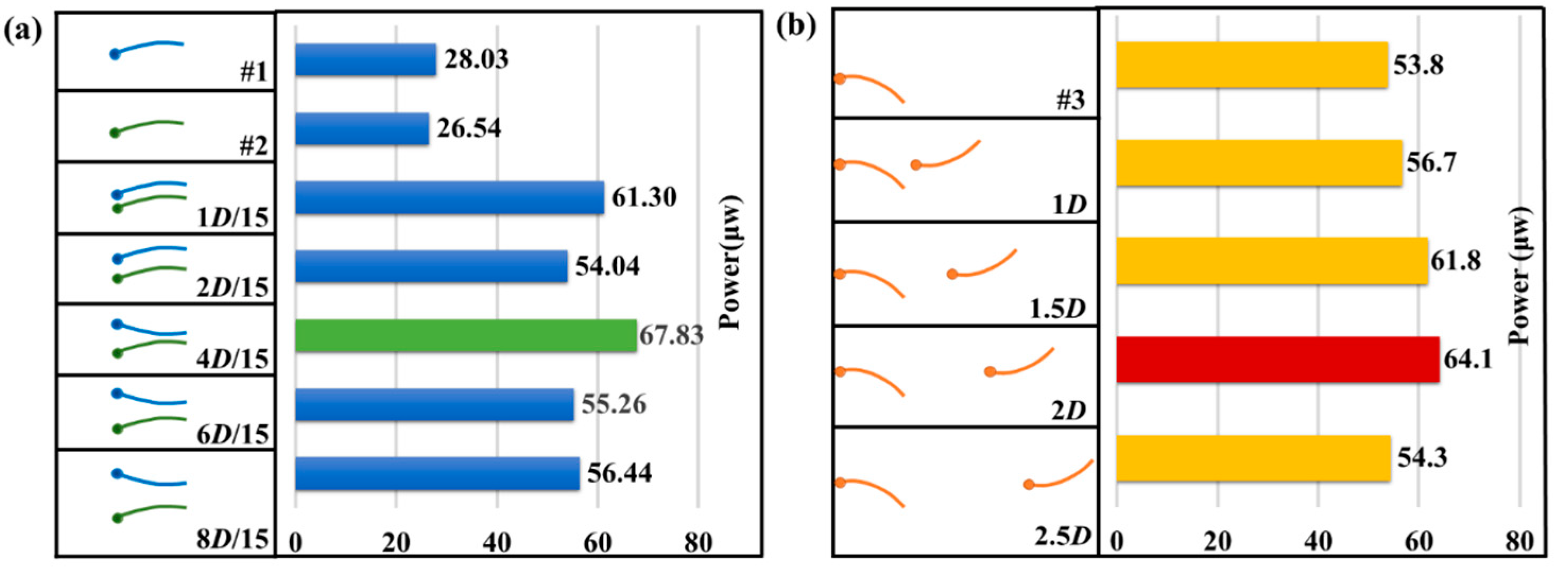
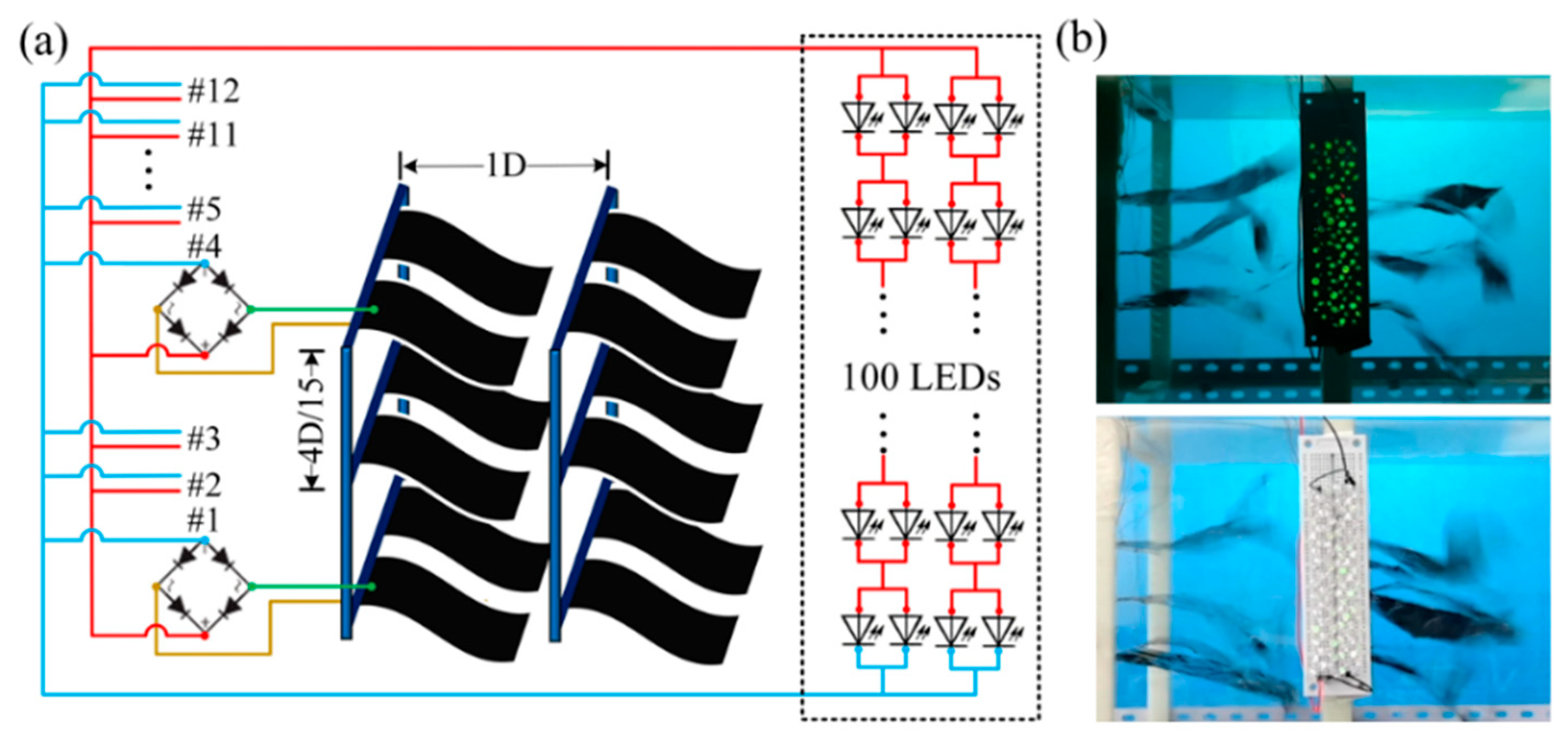
Publisher’s Note: MDPI stays neutral with regard to jurisdictional claims in published maps and institutional affiliations. |
© 2022 by the authors. Licensee MDPI, Basel, Switzerland. This article is an open access article distributed under the terms and conditions of the Creative Commons Attribution (CC BY) license (https://creativecommons.org/licenses/by/4.0/).
Share and Cite
Zhao, Z.; Wei, B.; Wang, Y.; Huang, X.; Li, B.; Lin, F.; Ma, L.; Zhang, Q.; Zou, Y.; Yang, F.; et al. An Array of Flag-Type Triboelectric Nanogenerators for Harvesting Wind Energy. Nanomaterials 2022, 12, 721. https://doi.org/10.3390/nano12040721
Zhao Z, Wei B, Wang Y, Huang X, Li B, Lin F, Ma L, Zhang Q, Zou Y, Yang F, et al. An Array of Flag-Type Triboelectric Nanogenerators for Harvesting Wind Energy. Nanomaterials. 2022; 12(4):721. https://doi.org/10.3390/nano12040721
Chicago/Turabian StyleZhao, Zhiqiang, Bin Wei, Yan Wang, Xili Huang, Bo Li, Fang Lin, Long Ma, Qianxi Zhang, Yongjiu Zou, Fang Yang, and et al. 2022. "An Array of Flag-Type Triboelectric Nanogenerators for Harvesting Wind Energy" Nanomaterials 12, no. 4: 721. https://doi.org/10.3390/nano12040721
APA StyleZhao, Z., Wei, B., Wang, Y., Huang, X., Li, B., Lin, F., Ma, L., Zhang, Q., Zou, Y., Yang, F., Pang, H., Xu, J., & Pan, X. (2022). An Array of Flag-Type Triboelectric Nanogenerators for Harvesting Wind Energy. Nanomaterials, 12(4), 721. https://doi.org/10.3390/nano12040721






